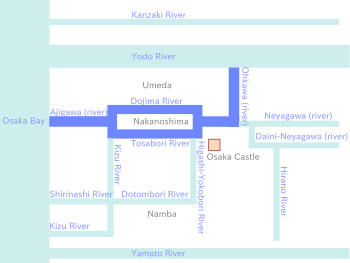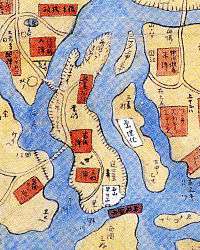Kyū-Yodo River
The Kyū-Yodo River (旧淀川, Kyū-Yodo-gawa) was the main stream of the Yodo River before 1907, when the current (new) Yodo River was constructed by a normalisation project. Now called the Kyū-Yodo River, it is a major waterway in central Osaka and the main drainage of Neyagawa river.
| Kyū-Yodo River | |
|---|---|
 | |
| Location | |
| Country | Osaka City, Japan |
| Physical characteristics | |
| Source | |
| • location | Yodo River, at Kema Lock |
| • coordinates | 34°43′15″N 135°30′59″E |
| Mouth | |
• location | Osaka Bay, at Tempozan |
• coordinates | 34°39′31″N 135°25′51″E |
• elevation | 0 m (0 ft) |
| Length | 13.83 km (8.59 mi) |
The name Kyū-Yodo river means former Yodo river in Japanese.
Subdivisions

The name Kyū-Yodo River is a geological name, locally it is called by subdivision names. From the source to the mouth, it is named as follows:
Ōkawa (river)
This is the name for the section from the Kema Lock to the Tenjimbashi (bridge); the Japanese name is Ōkawa (大川).
Dōjima River

This is the name for the section from the Tenjimbashi (bridge) to the Funatsubashi (bridge) along the north shore of Nakanoshima Island; the Japanese name is Dōjima-gawa (堂島川).
Tosabori River
This is the name for the section from the Tenjimbashi (bridge) to the Funatsubashi (bridge) along the south shore of Nakanoshima Island; the Japanese name is Tosabori-gawa (土佐堀川).
Points of interest
Points of interest from the source to the mouth.
- Yodo River
- Kema Lock
- Kema Sakuranomiya Park
- OAP Tower
- Imperial Hotel Osaka
- National Mint Factory
- Keihan City Mall (department store)
- Minami-Temma Park
- Nakanoshima
- Nakanoshima Park
- Osaka Stock Exchange
- Museum of Oriental Ceramics
- City Hall
- High District Court Osaka branch
- Bank of Japan Osaka branch
- Hotarumachi
- National Museum of Art, Osaka
- Osaka Science Museum
- Rihga Royal Hotel
- Osaka International Convention Center
- Osaka Central Wholesale Market
| Wikimedia Commons has media related to Kyu-Yodo River. |
- Universal Studios Japan
- Osaka Aquarium Kaiyukan
- Tempōzan
Access
For Nakanoshima area, each station of Keihan Nakanoshima Line is nearest. For Osaka Aquarium Kaiyukan and Tempōzan, Metro Ōsakakō Station is nearest.